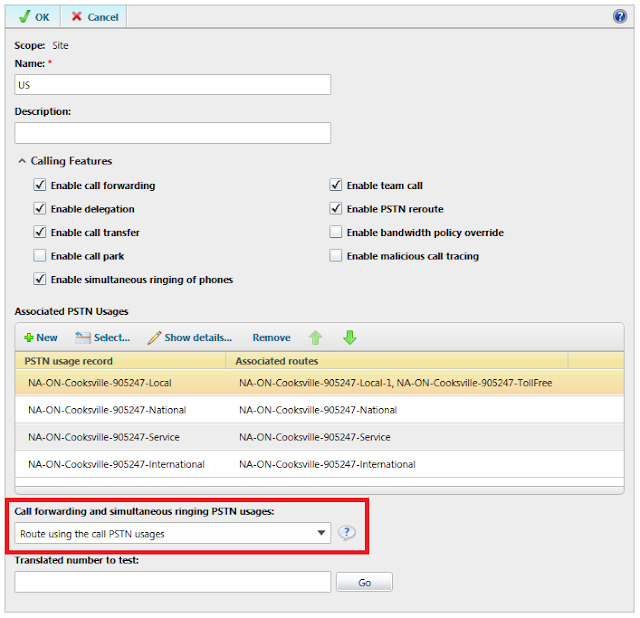In Lync 2010, users were able to forward calls or setup simultaneous ringing to any number that they were able to call themselves. This could lead to people forwarding all their calls to a long distance or even international number (assuming their voice policy allowed international calling). This can lead to increased telephony costs to the company, and there wasn't very much the administrator could do to control this, short of disabling the feature entirely.
A new feature in Lync Server 2013 Enterprise Voice allows administrators to limit where users are able to setup call forwarding/simultaneous ringing. You'll see the new option at the bottom of the voice policy screen in Lync 2013 Control Panel (as highlighted in red).
The selectable options are:
Route using the call PSTN usages (default) - essentially means to allow users to forward calls to any destination phone number they are allowed to call (the same behaviour as in Lync 2010). So if a user is allowed to call international numbers, they will be allowed to forward/simultaneous ring international numbers. The option wording here could really use some improvement, because to me it doesn't make much sense as it currently stands.
Route to internal Lync users only - allows call forwarding/simultaneous ringing only to other Lync users within the company.
Route calls using custom PSTN usages - allows administrators to limit call forwarding/simultaneous ringing to only the PSTN usages defined by the administrator.
When the last option is selected, the Control Panel will display a box where administrators can select the appropriate PSTN usages. For instance, to limit call forwarding/simultaneous ringing to only local numbers, select a local PSTN usage, as shown below:
Administrators can add multiple usages to allow calls forwarding/simultaneous ringing to any combination of PSTN usages. Since voice policies can be applied either globally, site-wide or down to the user level, this should allow administrators to grant different policies to any number of users.
This assumes the Enterprise Voice deployment has been designed granular enough to break out local, national and international calling. If there is only a single catch-all usage for all calls, then this won't work and the Enterprise Voice configuration will have to be re-designed.
Luckily, the Lync Dialing Rule Optimizer (shameless plug) creates usages for local, mobile, national, premium, and international usages, which should be enough for any administrative need.
Unfortunately from the user's perspective, they won't get a notification in the Lync client if they try to forward/simultaneous ring a phone number that is outside the dialing areas allowed by their voice policy.
For example, assume a user's voice policy only allows forwarding/simultaneous ringing to local numbers. If the user sets up simultaneous ringing to a number outside the local dialing area, they won't get any feedback that it isn't allowed by the policy. When someone phones the user, their Lync devices will ring as usual, but the simultaneous ring number simply won't ring. This could generate an unnecessary helpdesk call, which could also confuse the helpdesk, if they haven't been made aware of the policy.
Similarily, the user doesn't get any feedback in the Lync client when setting up call forwarding to a number outside the allowed dialing areas. In this case, calls will simply go straight to Exchange voicemail without attempting to forward. However, the user will get an email stating the forwarding isn't allowed. Slightly more helpful, but still likely to generate a helpdesk call.
Curiously, the interface still refers to Office Communicator, but since I'm still running Exchange 2010, maybe this is to be expected.
The situation would be greatly improved if the Lync client would be more informative in this respect. In my perfect world, there would be no war, global warming would turn Canada into a tropical paradise, gin and tonic would flow freely from taps all around my house, and the Lync client would provide feedback like this when users try to forward to a number that isn't allowed:
A man can dream, can't he?
Either way, the new control administrators have to limit call-forwarding/simulring is a much needed new feature, and I'm glad it made it into Lync 2013.









0 komentar:
Posting Komentar